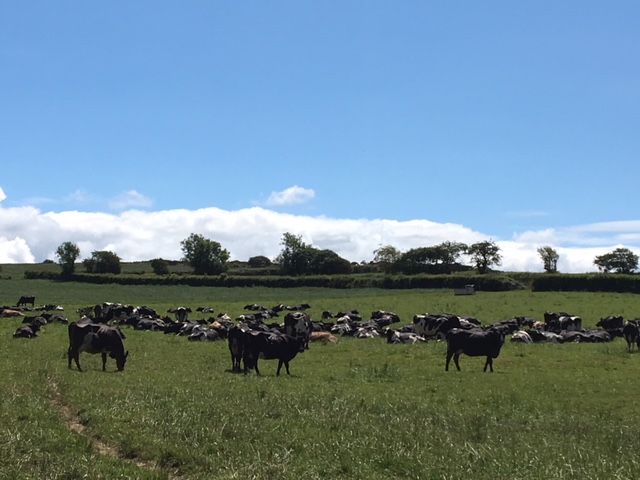Understanding causes of mastitis key to control
Thursday, 17 September 2020
By putting a Mastitis Control Plan in place, farmer Chris Mossman has seen cases of mastitis fall drastically in his herd at Nantybach Farm.
Chris Mossman manages a herd of crossbred, spring calving dairy cows in Llangrannog, Ceredigion. In the summer of 2018, they saw an increase in the cases of clinical mastitis which took the incident rate above the national average of 30 cases per 100 cows. Chris and his team decided to take a proactive approach to understand the causes of mastitis and have a plan to tackle them.
The farm is one of 500 farms selected by AHDB to take part in its HerdAdvance project, which aims to help Welsh dairy farmers lift profitability and performance by focusing on improved herd health management and disease control.
Anna Bowen, AHDB animal health knowledge exchange manager, visited the farm and met the farm vet and it was agreed that putting a Mastitis Control Plan in place would be beneficial. The aim of the plan is to lower cases of clinical mastitis and high cell count incidence by providing an achievable set of action points relevant to the farm.
Identifying the sources of mastitis
First of all, the milking team were asked to freeze aseptic milk samples from a mixture of clinical cases and high somatic cell count (SSC) cows.
Anna observed the milking routine, measured feeding and housing areas and completed a questionnaire about farm management. The farm carries out monthly milk recording with the Cattle Information Service (CIS). Data was taken from the milk recording software and run through the Mastitis Pattern Tool.
This showed that the main mastitis issue was environmental and mainly during the dry period, although in the summer there had also been an issue during lactation. Based on this, Anna prepared an Environmental Lactation Action Plan, which included a number of changes for Chris and his team to make.
Tests on the milk samples showed that some of the cows were infected with a Pseudomonas bacterium that could be linked to the water supply and so additional water testing was advised. The 2018 drought was a significant factor in the spike in cases and so some of the actions were for occasions when grass growth dropped and cows were held in paddocks for supplementary feeding.
As the herd is spring block calving, they decided to focus on lactation over the summer. In the autumn of 2019, Anna returned with a Dry Period Action Plan, and the farm team looked at changes that could be made to dry cow management.
Addressing mastitis issues
As a result of the plans, Chris’ team started pre-wiping cows in the parlour before milking and additional grooving was added to concrete to avoid slipping. They began planning for backfencing and managing paddocks where bare soil is present or when cows are repeatedly using a paddock for supplementary feeding. Cows that recorded high SCC were monitored and treated as appropriate.
Dry cow housing and cubicle management was improved, including increasing the space per cow and feeding space. They also use milk recording data to look at cows before and after drying off to see when they may be picking up infection.
Reduction in incidences of mastitis
Chris said: “By implementing the recommendations Anna drew up for us, staff have seen positive results for their efforts very quickly. By looking at the way we manage the cows during key times, we have drastically reduced the cases of mastitis on farm. We recently had an increase in mastitis cases and were able to check the plan and act accordingly to reduce it. It’s also a good way to reduce antibiotic use.
“We’ve also met with vet James Breen to do some additional work on how we use data which has helped with managing mastitis and the data actions in the plan.
“The control plans were easy to follow and gave clear guidance on what we needed to change in order to see improvements. The help we received from Anna has been great and I would say to anyone else struggling to manage mastitis in their herd, speak to your vet about putting a Mastitis Control Plan in place.”
As a result of these changes, calving 2020 had significantly fewer mastitis incidences during the dry period and as of June 2020, there were no cases during lactation. Looking to Winter 2020/2021, they are looking to further improve the management of heifers, which includes using external teat sealants to offer extra protection.
Anna says: “Identifying the areas that may be causing a mastitis issue in your herd is the first step to bringing cases down. Simple changes can make a big difference to the health of your herd. The Mastitis Control Plans are clear and easy to follow and specific to your farm. When creating a plan, I look at all aspects of the farm to provide the farmer with a structured approach to mastitis prevention and control.”



